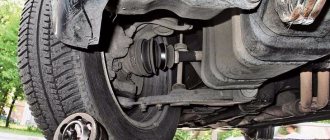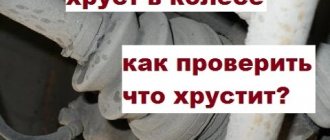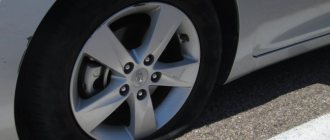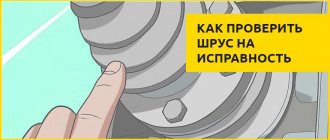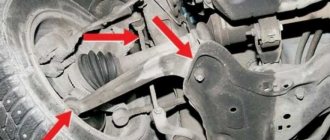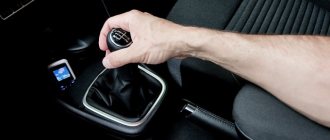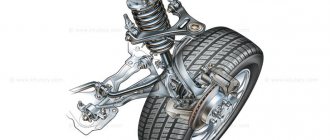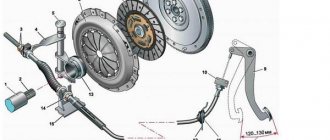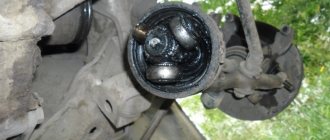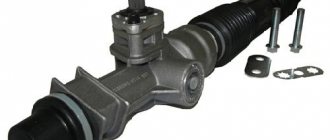When operating a car with front- or all-wheel drive, the driver may hear a crunching sound when turning the steering wheel to the right or left. Often in this case the CV joint (constant velocity joint or just a grenade) crunches. The sound is characteristic and resembles a booming crack.
It is important to accurately determine:
- which CV joint crunches;
- the severity of the failure;
- Is it possible to get to the service station on your own?
The fact is that on each side there is an internal CV joint, as well as an external CV joint. For diagnosis, it is necessary to separately take into account some features and nuances. Read more in our article.
CV joint: what is it and how does it work
CV joint (constant velocity joint) is a part that transmits torque between axle shafts, while the angle between the axle shafts is constantly changing. CV joints are actively used in cars with front-wheel drive and all-wheel drive.
On the front axle the following are used:
- internal CV joint (internal CV joint);
- outer CV joint (outer grenade);
The inner CV joint is responsible for transmitting rotation from the gearbox to the shaft, while the outer joint transmits rotation from the inner one to the wheel. The use of these elements allows you to transmit torque and turn the drive wheels of the car.
Loose steering wheel
Such problems include: weakening of the steering column bracket, steering mechanism, rack adjusting bolt, steering rod ball pins, bolt securing the lower flange of the elastic coupling to the gear shaft. The solution is similar to the previous one: you should also tighten the threaded connections. But this alone will not be enough.
The steering rack also needs to be adjusted. You can do this yourself, without removing it. You will need a 17mm octagon wrench. You can get to the rack by sticking your hand into the vacuum brake booster.
Why does the grenade crunch?
In general, the constant velocity joint is a fairly reliable part. Natural wear and tear occurs over long runs (about 150-200 thousand km or more). However, in some cases, a part may fail earlier for certain reasons.
In this case, the main sign of problems with the joint is a characteristic cracking sound (often the CV joint crunches when turning). The crunch of a grenade can also be heard when accelerating a car (especially pronounced with the wheels turned out).
The main causes of CV joint crunching:
- operating a vehicle in difficult conditions (off-road, falling into potholes at high speeds, towing heavy trailers, transporting goods, etc.).
- aggressive driving, sudden acceleration and emergency braking (especially with the wheels turned out), taking sharp turns at high speed, etc.
- rupture of the CV boot, moisture, dirt and dust entering the mechanism (CV joint lubricant accumulates particles and begins to work like an abrasive, destroying the part). By the way, the vast majority of problems with CV joints are associated with damage to the boot;
To understand which CV joint makes a crunching sound when you turn the steering wheel, you need to carry out diagnostics. At the same time, it is not particularly difficult to quickly determine which CV joint is crunching. As part of the inspection, you should pay attention to some features.
- Crunching and squeaking noises are usually produced by the external grenade. You can check the CV joint by turning the wheels and starting active acceleration. As a rule, a not particularly strong crunch when turning will become louder. You should also pay attention to the steering wheel. If vibrations and slight jolts are felt on the steering wheel, this will also indicate problems with the outer joints.
- The inner CV joint usually does not crunch, but slightly taps when driving with the wheels evenly aligned in a straight line. In addition to driving on a flat road, when you hit potholes, the knocking intensifies. The fact is that the load on the inner CV joint is stronger depending on the depth of the hole under the wheels.
Grinding, as well as squeaking (the steering wheel turns both when driving and when standing still)
A grinding/creaking sound that is felt when the steering wheel is turned in different directions. This noise occurs due to wear on the suspension joints or steering joints. Similar to the previous point, here you will need to diagnose the suspension components or steering system, replacing worn parts, if necessary.
However, the most common reason for such a sound is the lack of lubrication in the steering tips (as well as their severe wear).
Thanks for subscribing!
Sometimes such a squeak can even be accompanied by a crunching sound, regardless of whether the car is moving or standing still. In this case, the culprits are the lower ball joints (sometimes the shock strut bearings). The first option is also accompanied by play in the steering wheel when the car is suspended.
When is a car's CV joint checked?
If the CV joint crunches, many drivers are interested in how long they can drive the car before repairing such a breakdown. In other words, how long can you drive if the CV joint crunches? There are several reasons why repairs are delayed:
- Constant velocity joints on some cars can be quite expensive.
- the crunching and knocking may not be strong, etc.;
First of all, the ability to operate the car depends on the severity of the breakdown. The more worn out the CV joint is, the sooner it needs to be replaced. In this case, knocking and crunching are indicators indicating the need for replacement.
For example, if the crunch is strong, it is better to change the joint immediately. The fact is that if the unit is completely broken (jamming, cracking of the body or balls falling out, etc.), you can get serious problems with other units, units and elements.
In turn, you can try to eliminate the symptoms of a malfunction at the initial stage using a maintenance method (lubricating the CV joint and replacing the boots). If there is no result, then you should prepare for the fact that with increased noise, knocking and crunching, the part will need to be changed. This can happen after 500-1000 km. after the first symptoms appear, or later.
At the same time, experts still do not recommend operating the car and subjecting the car to loads in the presence of such faults. This means that you can drive with a partially faulty CV joint for some time, however, the part should be replaced at the first opportunity and not delay the repair. If the signs of failure are serious (extreme noise and crunching), you should stop using it and replace the hinges.
How to check the outer CV joint
Having identified characteristic signs of a malfunction, an additional check of the CV joint is necessary. If you need to check the outer CV joint, there are some things to consider. The part is attached to the internal hinge through the axle shaft on one side, and attached to the hub on the other.
Considering that the hinge is a separator with balls, if the ball mechanism is damaged, a crunching sound appears. The case is also protected on top by a dust cover. If the boot is torn, moisture, dirt and dust get inside the CV joint and damage it.
In order to check the outer CV joint, you need to drive on a flat road, turning the wheels in one direction and the other until they stop. In the extreme positions of the steering wheel, you must press the gas. If the crunching intensifies, then the external grenade is faulty. In this case, a crunching sound when turning left will indicate that the CV joint on the right “passenger” side is faulty. If the sound appears in a right turn, in this case the left CV joint (on the driver’s side) crunches.
Checking the internal hinge
As for the inner CV joint, this element is structurally similar to a glass (there is an outer housing with bearings that move in three planes). The shaft is inserted into the gearbox, while the tripod with bearings is fixed to the axle shaft.
The design of the inner CV joint is extremely simple; the joint fails much less often than the outer one. However, the lack of lubrication in the inner CV joint and a torn boot can damage even such a reliable mechanism.
We also recommend reading the article on how to replace ball joints with your own hands. From this article you will learn about the features of replacing ball joints, as well as how to change ball joints correctly and what needs to be taken into account if such a replacement is performed.
To check internal grenades, you need to select a section of the road where there are holes and uneven spots. The main symptom of a faulty internal joint is a knocking sound when the wheel hits a hole. Please note that before checking, it is advisable to perform chassis diagnostics to rule out other possible causes of knocking.
There is another method of checking - you can load the rear axle of the car to such an extent that the “nose” of the car rises higher, and the axis of the inner CV joint deflects. If a knock occurs under such conditions, this means that the internal CV joint has failed.
Other verification methods
As part of diagnosing constant velocity joints, you also need to know another way to determine which CV joint is crunching. However, this method is only suitable for cars with a manual transmission. The tool you will need for checking is a jack.
- First, the car is placed on a level surface;
- The wheels are set straight and hung out;
- By tightening the handbrake, the engine starts in neutral gear;
- Then, after squeezing the clutch, first speed is engaged;
- Then, in the cabin, the gas pedal is pressed and the brake pedal is carefully pressed (a load is created on the CV joint).
We also recommend reading the article about what signs indicate problems with anti-roll bar bushings. From this article you will learn what stabilizer bushings are intended for, as well as when and why they need to be changed, and how to replace stabilizer bushings with your own hands.
If the inner CV joint breaks, knocking noises will be heard when you press the brake. If the internal CV joints are working properly, the engine will stall and there will be no extraneous knocking noises. Next, turn the steering wheel all the way to the left or right and press the brake. If a crunching sound is added to the knocking sound, the external grenade is also faulty. Using this method, you can check the CV joints on the axle shafts on both sides.
Rumble (steering wheel turns, car stops)
Typically, this sound is produced by the hydraulic booster, which is installed on many cars. And there is nothing scary about this noise. When you get into the car, you may feel this sound - now you know that it will appear regularly. It is extremely rare that such a sound is detected when the steering wheel is turned in only one direction.
It seems that you have become accustomed to this sound, the car has been used for a long time, but the hum becomes louder and more distinct - now it can be heard not only when turning the steering wheel in the absence of movement, but also while driving. Here, be sure to try diagnosing the power steering. The most common cause of such noise is a lack of special power steering fluid, so the problem is often solved when such fluid is added to the power steering reservoir located under the hood (it is marked with MIN and MAX marks, they mean the maximum and minimum amount of fluid). Obviously, at the MIN level, fluid is most likely leaking from the system, so after topping up, you will need to check this level for some time (at least once a week).
The noise may also be caused by a breakdown of the power steering pump, weak tension of the power steering belt, as well as air flow that has penetrated into the power steering circuit. Alas, in all these cases you should definitely contact a car repair shop.
As a rule, problems with power steering are almost always accompanied by the need to apply more force than usual to turn the steering wheel.
Recommendations
As a rule, the main problem with CV joints is damage to the joint boots. For this reason, their condition must be constantly monitored at every maintenance. Even the slightest damage (cracks, tears, holes and other defects) is not allowed. If such defects are found, the CV joint boot must be replaced immediately. Please note that ignoring this rule leads to breakdown of this unit.
Moreover, if the CV joint crunches, this indicates critical wear. In practice, the problem can be “preserved” by updating the joint lubrication. However, this does not allow us to talk about the reliability and durability of the unit after such maintenance.
We also add that the maximum load on the CV joint is created if the driver accelerates heavily with the wheels turned out. If there is such an opportunity and you need to overcome an obstacle (for example, driving onto a curb or accelerating sharply when turning), it is better to put the wheels as straight as possible in order to reduce the load on the CV joint.
Tags: Priora sedan
Comments 25
listen, what kind of photo is this?
Thanks everyone, I fixed everything, it was a matter of loose bolts near the wipers, tightened it up and everything was quiet)) once again, THANK YOU all so much!
For 2 months I racked my brains and eliminated my suspicions (I glued the pillar, took off the mirror, re-glued the door trim, smeared the awnings) and, strangely enough, all this helped for 5, 10 minutes of driving and again a pain in the ass, until I tightened the screws securing the plastic under the wipers and now the miracle has happened - the long-awaited silence
Got it, thanks, I'll give it a spin! =)
I also had sound in this place, sometimes there, sometimes not. I was scratching my head about what it could be, but it turned out that under the hood, in the area where the support is screwed on, there is a tube, or rather two, there is a clamp on it and on this clamp there is a bolt, and so it was rubbing against the iron from where the stand with the support comes out. I filed the bolt and everything was gone - now there is silence.
but I don’t have a photo where I can even look, but I’m just not good with cars! Visually, I should at least look where to look!
a friend of mine removed the glass and put me new velvet covers from some foreign car under the door trim; they press the glass tightly and don’t scratch
I understand, but could you find out from which one if it’s not difficult?
on Priora they are on sale for 500 rubles 4pcs
The noise I had on this side was coming from the mirror (I fixed it) the noise on the same side was when the window was open and the glass was hanging (it was fixed) the noise from the side of the shell was rubbing against the dashboard when it was closed (I fixed it) the right pillar rattled in it, plastic clips were placed through the seal ( fixed it) but most importantly, the door itself as a whole was rattling and rustling and the sound was coming from the top of the torpedo, it glued the whole door, there was deathly silence)
Wow, the robots have done a lot of work! Thanks a lot!
The noise I had on this side was coming from the mirror (I fixed it) the noise on the same side was when the window was open and the glass was hanging (it was fixed) the noise from the side of the shell was rubbing against the dashboard when it was closed (I fixed it) the right pillar rattled in it, plastic clips were placed through the seal ( fixed it) but most importantly, the door itself as a whole was rattling and rustling and the sound was coming from the top of the torpedo, it glued the whole door, there was deathly silence)
How did you fix the problem with the glass that they were hanging out?
well, it’s on clips, pry it off with a screwdriver and that’s it
It was on this side that the pillar panel creaked for me. It touched the bottom of the torpedo and made an terribly disgusting sound. It helped to tuck a folded piece of paper in there =)
+1 I had this happen too, I cured it with a small piece of madeleine
ugh, fuck, I look at the main photo and think: “this is a dude, he cut off the roof for the sake of a squeak. can we make a convertible?” It’s a good thing I looked at the floor, otherwise I would definitely have been constantly analyzing this thought))
There is the same problem, only this sound may not be there for a couple of months, then it will be fixed for a day and again there will be no sound for a week, but it is not constant, so I did not look for the reason, but I will take note of the comments)
I also got it not so long ago, but it’s just terrifying! =)
In general, I had a problem from the street about the windshield, plastic scuffling in the lower corner!
Communities › Lada Priora Club › Blog › Eliminating noise and squeaking in the trunk
Good day.
I haven’t written on this blog for a long time, but now the reason to write was born.
I hasten to share with my comrades who have wonderful
hatchback body how to partially eliminate noise in the rear of the car.
Actually, I can’t say that it’s really noisy, but personally, I didn’t experience a real rattle. It is not too noisy, but is constant while driving. I couldn’t understand what was wrong, but the issue was resolved.
For those who have a creak.
The issue was resolved with tie rod plugs from a VAZ 2108, I bought two of them for 25 rubles apiece.
For those who constantly have something rattling.
I couldn’t understand what was rattling, I touched everything.
I rewound all the wires in Madeleine/Bitoplast. It started creaking, I removed the bitoplast, it really creaks, don’t use it! It doesn't even squeak as much as it rubs; in general, the sound is not pleasant.
Let's return to the fact that everything is wrapped in madeleine, everything is tightly planted, the shelf is checked forty times, and then completely removed.
It's not about the shelf! This is what I found out. Not in wires. I removed all the plastic from the back. And it turned out that it wasn’t him. Everything is as always in the trunk lid. Noisy father
by her leg.
Then a suggestive moment happened:
I was putting the bags in the trunk and
BAAAAH
, Tyson himself hit me, I immediately spat out my false jaw,
NICHOSI
, the stops don’t hold, and the trunk weighs a ton no less... such things, but I have it
welded and glued
. After that decided not to delay and buy stops.
I drove everywhere until I found Fenox for 2112, it has the highest pressure, judging by what Google told me, 460H. Two pieces for 498 rubles each. I already had ones from 2112, because... they are more powerful than on 2170. There was pinzes on the street:
Preventing knocking noises
All of the above problems can arise not only with domestic cars, but also with expensive foreign cars. And the difference between these cars comes down only to the time after which the malfunction appears.
Naturally, a foreign car will pass more without a malfunction than the same Priora. But repairing a foreign car, if, for example, its CV joint has failed, will cost much more.
In most cases, knocking noises are caused by inadequate road surfaces. Moving over bumps and holes leads to the fact that all fasteners begin to weaken, hence the appearance of backlash.
Knocking in a car engine, causes, diagnostic methods
To prevent knocking noises when turning the steering wheel, periodic inspection of all elements is required. Moreover, this will require very little, and you can do everything yourself.
The car is placed on an inspection hole or overpass, after which, while under it, you should carefully inspect all the elements, check the tightness of all fasteners with wrenches, tighten the nuts and bolts if necessary, swing the levers with a pry bar, checking for play.
If you do all this periodically, you can avoid the occurrence of knocking noises, or at least increase the life of the car before they occur.
Also, when traveling, you need to adhere to the speed limit, and go through difficult sections at low speed in order to slightly reduce the load on the elements of the suspension steering mechanism.
And if in front of you unexpectedly there are depressions in the road surface, then slow down the car (the car will seem to nose down), and immediately before the problem section of the road, release the brake pedal.
The front of the car will rise, thereby unloading the front suspension, and the car will coast over uneven roads without much damage to the chassis.
Shock absorbers (struts)
If you take a classic VAZ 2101 - 2107 car, then either the shock absorber itself (strut) or its mounting location may knock, provided that the bracket is released.
The lower silent block of the shock absorber may also knock.
If the strut is unscrewed at the top or the upper bushings are worn out, this can also lead to knocking noises on bumps.
Pay attention to the spring; if it is broken, knocking noises will be heard due to the coils playing with each other; this is also typical for other car models. As for shock absorbers VAZ 2108/09/10 and above, a slightly different picture emerges here
As for shock absorbers VAZ 2108/09/10 and higher, a slightly different picture emerges here.
If the supports and ball bearings are intact, and the sound comes from the strut area, then it is possible that the shock absorber nut is knocking, especially on bumps.
Those. A small gap may form between the nut, strut and shock absorber, which will lead to knocking.
To solve this problem you need to tighten the nut. To do this, jack up the car and insert a wooden stop between the disc and the side member to prevent the wheel from spinning.
Lift the corrugation and lubricate the threads of the rack with oil (can be worked off).
Take a number 3 gas wrench and use it to tighten the nut. Use a pipe for leverage.
Well, check the rack for leaks; if it is broken, it can also knock.
If two front struts are broken, then during sharp braking the car will nod off, and when accelerating, the front end will lift up.
